While picking out the perfect mechanical keyboard switch for typing ultimately comes down to user preference, there are a few switches that are commonly agreed upon to be excellent for the purpose of typing.
When picking out the best switch for typing, typically a tactile switch is preferred because the tactile bump can help reduce error and make typing more enjoyable. The best mechanical switches for typing are Cherry MX Browns, ZealPC Zilents, and Topre switches.
There are many different tactile switches out there with differences in spring force, travel distance, sound, and feel. Continue reading for some of our best switch picks for typing and why.
The Best Switches For Typing: Our Top Picks
| The Award | The Switch | Noise Level |
|---|---|---|
| Best All-Around | Cherry MX Brown | Medium |
| Silent Typing | ZealPC Zilent | Quiet |
| Best Feel | Topre | Medium |
Best All-Around Switch for Typing: Cherry MX Brown
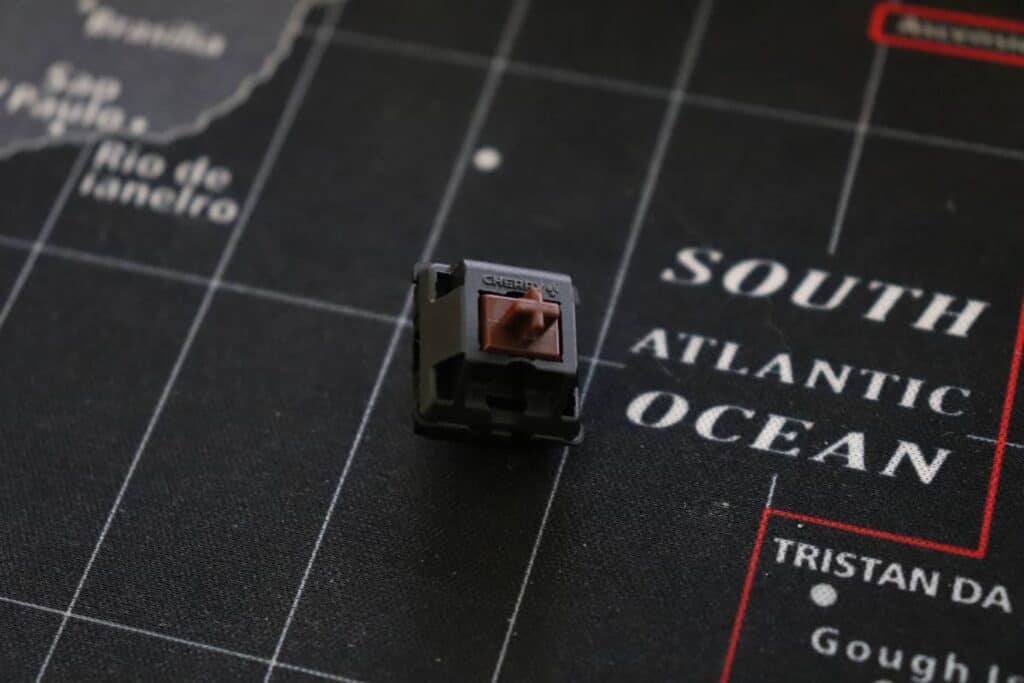
Cherry MX Browns are an all-around great tactile switch. Their total travel distance is 4.0mm with the actuation point at 2.0mm.
The actuation force is about 45g with a bottom-out force of 55g.
The tactile bump occurs in the middle and is a small and light bump. For many, this is all they need to feel to know that it’s time to move onto the next letter.
This switch is relatively quiet. Although, in an office environment, the sound of this switch bottoming out could still disturb your neighbors.
Because of the soft bump, and it will not tire out your fingers after long typing sessions. The distance is perfect to forgive typing errors or mistakes and allows finger lift-off before committing to the typo.
Cherry MX Browns are common in many prebuilt mechanical keyboards and are in big branded company keyboards such as Leopold, Ducky, Durgod, Corsair, and more.
Best Silent Switch for Typing: ZealPC Zilent
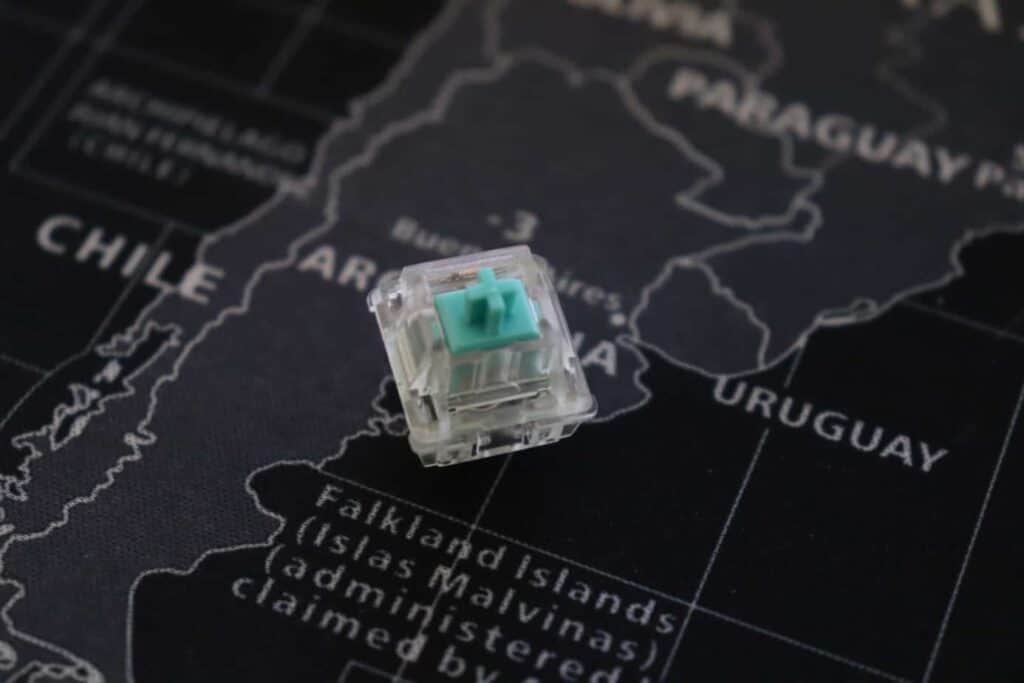
ZealPC Zilent switches are not commonly found in prebuilt mechanical keyboards.
However, for a quiet environment such as a library or office space, silent tactile switches are the preferred switch to not disturb your neighbors yet still enjoy the tactile bump that tactile switches offer.
Silent switches are known for their low noise levels because the legs of the stem in each switch have a small amount of sound dampening material attached to them.
When the switch bottoms out, that material touches the bottom housing of the switch, which produces little noise.
ZealPC Zilents can be found on many mechanical keyboard vendor websites. With these switches, you will have to solder them into prebuilt mechanical keyboards, replace switches in a hot-swappable mechanical keyboard, or build a custom for yourself.
The alternative to ZealPC Zilents, albeit not as good because of their lack of a good tactile bump, are Cherry MX Silent Reds. These are commonly found on prebuilt mechanical keyboards, so no extra work will be needed, but they are linear switches that are quite light in spring force, which could add to typing mistakes when typing.
Zilents offer a big tactile bump and have many different options for spring force from 62g to 78g (bottom out force numbers).
Depending on the spring force you choose, their tactile feel will vary. You can check the price on mechanicalkeyboards.com.
Best Feeling Switch for Typing: Topre Switches
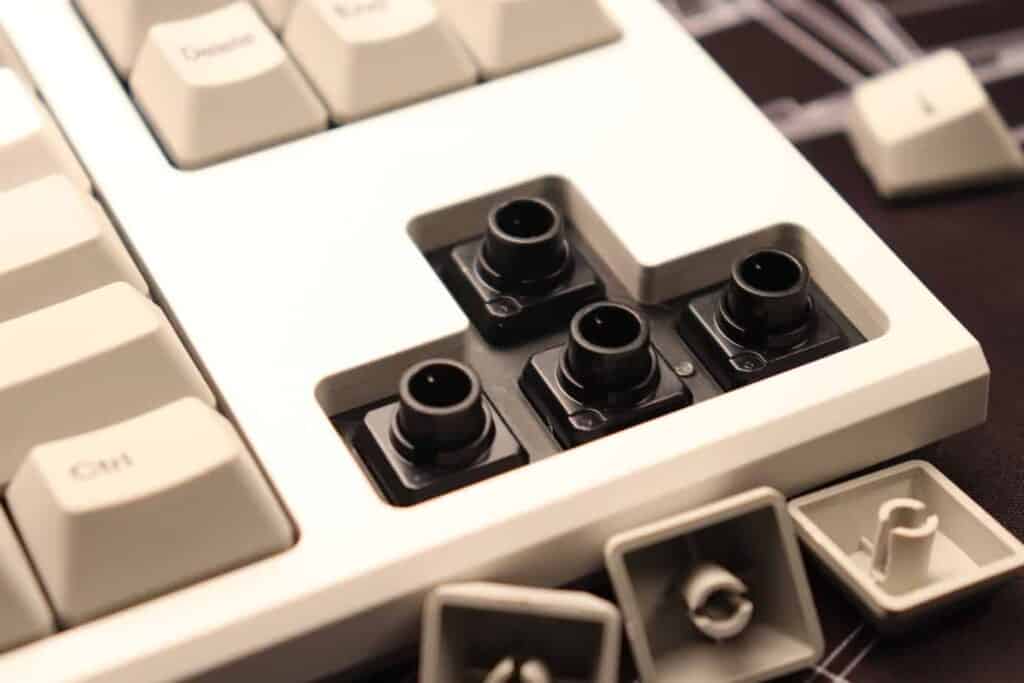
When it comes to typing, many people are accustomed to their membrane or rubber dome keyboards that are typically seen in office and work environments.
These membrane keyboards come stock with prebuilt computers and can be bought for very little at most technology stores such as Best Buy, Target, Fry’s, and Walmart.
The mechanical alternative to these membrane switches would be Topre switches.
Topre switches are a rubber dome switch with a spring inside. Topre switches are electrostatic, capacitive keyboard switches that have the feel of a rubber dome switch but also have the benefits of a mechanical switch such as tactility, less noise, and a non-mushy bottoming out.
You can read about our favorite Topre keyboards, if you are interested.
These Topre switches are found in a variety of prebuilt mechanical keyboards such as the HHKB (Happy Hacking Keyboard), Leopold FC660C, Topre Realforce, Leopold FC980C, and more.
Topre switches are similar to Cherry MX Brown switches, but they have a better “thonk” sound and more tactility. It is possible to silence them and lube them to decrease the sound that they make.
For a sound test for lubed and silenced Topre switches, see the video below that features a HHKB with Topre 55g switches.
In comparison, the stock Topre switch sound is much louder and may not be as accepted by desk neighbors. In the comfort of your own home, these are an excellent choice.
What to Look for in a Switch for Typing
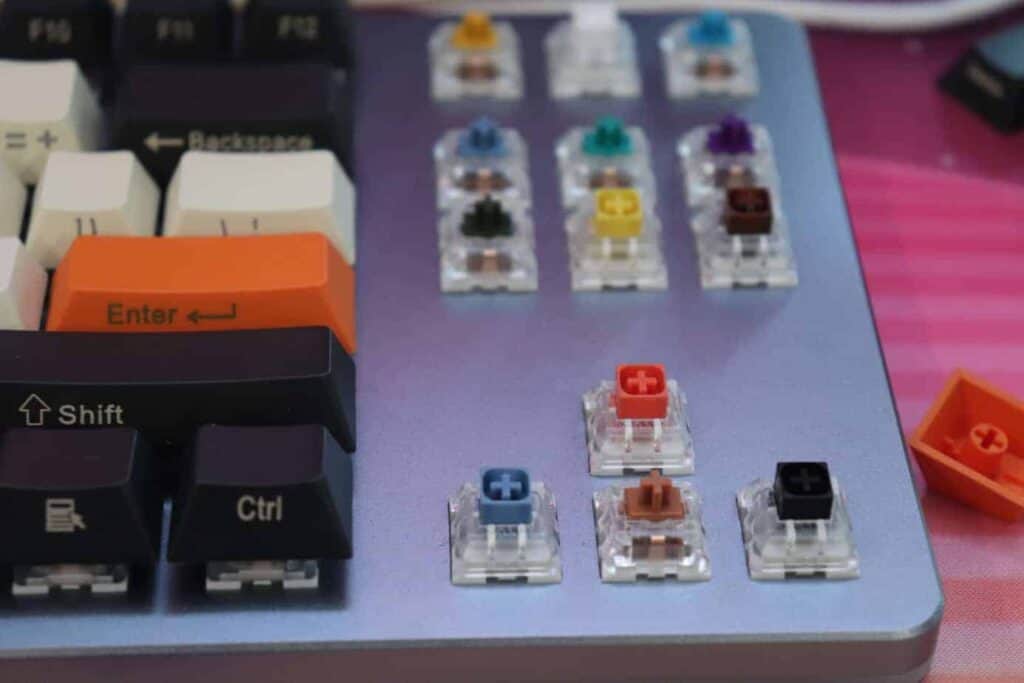
- Actuation Type
- Actuation Force
- Travel Distance
- Noise Level
When looking for the ideal switch for typing there are few different aspects to look at including actuation type, spring heaviness, and travel distance. We’ll go over each one and explain how to pick the best switch based on these features.
Actuation type
When looking for mechanical switches, there are three types of switches. These are linear, tactile, and clicky.
Linear switches are smooth and consistent throughout the entire keypress with a quiet noise. Tactile switches have a small bump during each keypress with no audible click.
Clicky switches have a bump on each keystroke and have a mechanism that purposefully produces a loud audible click.
When typing, it is beneficial to be able to feel when the switch you are pressing is registering your keypress.
Oftentimes, the tactile bump on tactile and clicky switches is near the point of actuation, the distance at which your key switch sent off a message to your computer saying you pressed it.
When typing on linear switches, it is easier to undershoot a keypress and move on to another letter. If this occurs, you don’t realize you missed it until you’re one or two words over already.
The best actuation type for typing is either tactile or clicky. Whether you want to hear the audible click or not is up to you and all boils down to preference.
If you’re going to the office, the best option would be to go for a tactile switch, possibly even a silent tactile switch that we’ll discuss in our switch recommendations.
If noise is no issue, then a clicky switch will work as well. Generally, the tactile bump on a clicky switch is more prominent than that of tactile switches.
Actuation Force
When typing, you use all of your fingers to type, including your strong index fingers and your weak pinky fingers.
When keeping all of your fingers in mind, the spring force needs to be at a level that isn’t too easy to accidentally press but also not too heavy so that your pinky finger can press it too.
Each mechanical switch has a spring in the middle, providing the resistance that you feel when pressing on them.
Many times, when you research a switch, they are rated in grams such as 35g all the way to 100g. This resistance is variable throughout the keypress, and you will see terms such as bottom-out force or actuation force.
Bottom out force refers to the force required to press a switch all the way to the bottom, where it can no longer go further. Actuation force refers to the force required for the switch to send a signal to your computer.
Testing out different spring forces is recommended because this is different for each person.
Generally, an actuation force of about 45-50g is commonly used for switches. To some people, that may be too light. They may accidentally press the switches with just their fingers resting on the keys. However, for others, it could be perfect.
It is possible to switch out springs on switches by opening them up, taking out the stock spring, and replacing them with an alternative spring more suited for your needs.
We have a guide here on how to take apart a switch.
Travel Distance
Travel distance refers to the total length that you can press a switch until it bottoms out, until it can move no further.
Travel distances of 4.0mm are common and generally regarded as the standard for travel distance.
Speed switches are shorter than this and are recommended for gaming, where increased responsiveness and sensitivity are crucial for winning, although we question how effective they actually are. However, like spring force, this is also preference.
Some people prefer very short distances and use low-profile switches, mechanical switches that are supposed to feel similar to laptop-style chiclet keys.
For travel distance, I recommend anything between 3.5-4.0mm. The actuation point is somewhere in the middle, at around 2mm. This allows time and distance to forgive accidental presses.
Noise Level
An aspect of different switches that isn’t talked about enough are the different noise levels produced. The most loudest type of switches are typically clicky switches, followed by tactile, then by linear. If your typing in a public space, quiet switches are typically preferred.
Many switches will have a quiet variation that includes some rubber dampening to limit the vibration and noise output. Switches such as the Cherry MX Silent Red/Black and ZealPC Zilents make great options for those looking for a quiet switch.
You can read if silent switches are worth it here.
Other ways to improve typing experience
If you’re looking for others ways to improve your typing experience in ways other than just purchasing a new switch, you can look at factors such as ergonomics, possible keyboard modifications, and different keycap profiles to fine-tune your keyboard and turn yourself into a typing machine.
Ergonomics
Ergonomics is another aspect to think about when considering the typing experience. Usually, when thinking about ergonomic, people think about curved keyboards, standing desks, and comfortable yet excruciatingly expensive office chairs.
Many aspects of ergonomics can be manipulated for free without buying additional equipment. Things to consider are elbow angle, chair height, desk height, keyboard angle, and overall body posture.
For the desk setup, sitting in a chair is fine as long as many of your joints are at 90 degrees: elbows, knees, hips, and ankles. Find a footrest to rest your feet on if these angles are not achieved. Even with this position, constantly take rest breaks and walk away or stand up at your desk.
Keyboard angle matters too. Typing on a flat surface may be better than angled. Having a high inclination on a keyboard forces the wrists to go into additional wrist extension.
Being in this position for long periods of time increases chances of injury. Similar to taking breaks from your desk and sitting, take breaks from typing as well and roll out or stretch those wrists throughout their entire range of motion.
For more in-depth information about ergonomics, we have a full write-up here.
Lubed switches/stabs
Even after choosing out the perfect switch for you, there can be many adjustments that you can make to continually improve the typing experience. This includes lubing your switches and your stabilizers as well. We have complete guides to do each of these processes.
Lubing the switches can reduce the friction of the keypress itself as well as allow for a better buttery smooth feeling when a key is pressed.
Lubing stabilizers decrease the amount of rattle that you hear on your bigger keys such as space bar, enter, backspace, and shift. Alongside reducing sound, it also increases the stability and responsiveness of those keys too.
In other words, it makes the bigger key more responsive to your press whether you push it on the right or left or dead center on it.
Keycap Profile
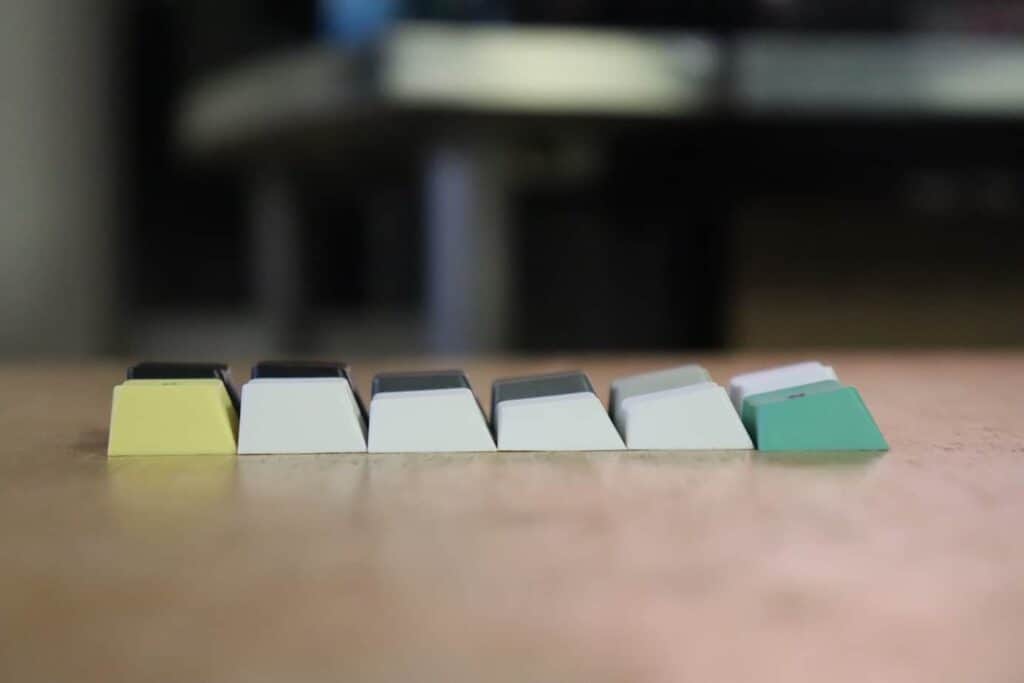
Different keycap profiles can affect the feeling of typing on your keyboard. There are different types of keycap profiles.
Sculpted keycaps are recommended compared to uniform keycaps. Uniform keycap profiles such as DSA or XDA make it difficult to feel for each key and separate the keyboard rows from each other, increasing the chances of typos.
They also don’t hug your fingertips and conform to its shape, allowing your fingertips to rest on each key comfortably.
Sculpted keycaps such as Cherry or OEM are preferred because they are different from row to row, with shape and height.
Cherry profile is recommended over OEM for typing because they are shorter. When you throw these keycaps on a keyboard, it reduces the height of the keycaps, thus decreasing the amount of wrist extension that you do and increases overall ergonomics and typing.
OEM profile keycaps are what comes standard on many prebuilt keyboards. After switching you a Cherry profile keycap set, you’ll be able to feel the difference in the height.
Conclusion
There are so many mechanical switches in the market nowadays. For typing, it is recommended to get a tactile or clicky switch rather than linear. For the office, a tactile switch is more acceptable because they produce less noise compared to clicky switches. If you are in your own home, then a clicky switch will provide the tactility as well.
The best three switches for typing are Cherry MX Browns, ZealPC Zilents, and Topre switches.
Each switch has its differentiating factors and benefits from the others. Cherry MX Browns are commonly found in prebuilt mechanical keyboards, easily accessible, and provide a small tactile bump just enough to feel while typing.
For a quiet switch that is appropriate for the office or school, Zilents have sound dampening materials within each switch to decrease sound. These are not found in prebuilt keycaps, so it involves more effort to replace switches or build a custom keyboard with these switches.
Topre switches are rubbed dome mechanical switches that use a no-contact actuation method. They feel the closest to common membrane keyboards that are used around the world but also offer the benefits of mechanical switches such as tactility, better sound, and a non-mushy feel.
It is possible to lube all of these switches to even further improve their feeling and sound while typing.
In the end, it all dials down to preference. We recommend getting a switch tester and trying out some of these switches before committing to a full mechanical keyboard full of them.
With Topre switches it is difficult to just try one. However, a friend or acquaintance may have one for you to test out. These are quite expensive keyboards, but many people commit fully to them after having one.
It’s up to you, good luck on finding the switch for you. Happy typing!
